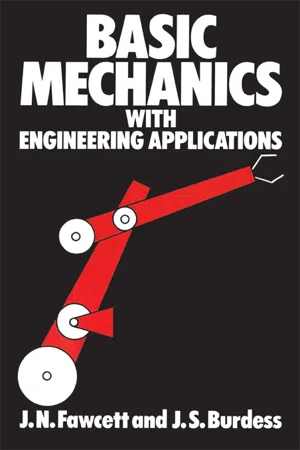Cartesian Vector
A Cartesian vector is a mathematical representation of a quantity that has both magnitude and direction. It is typically represented by an ordered set of components in a coordinate system, such as x, y, and z in three-dimensional space. Cartesian vectors are widely used in engineering and technology for describing forces, velocities, and other physical quantities in a precise and systematic manner.
6 Key excerpts on "Cartesian Vector"
- eBook - ePub
- Joy Ko, Kyle Steinfeld(Authors)
- 2018(Publication Date)
- Routledge(Publisher)
...1.03 VECTORS, POINTS, AND COORDINATE SYSTEMS Users of CAD systems will no doubt arrive to this discussion with an intuitive understanding for the three elemental geometric entities presented in this chapter: a point is a position in space, represented by a dot or an x on the screen; a vector is a quantity which has both length and direction, commonly represented graphically as an arrow; and a coordinate system is a construct that orients us to the view in which we are drawing, often appearing on the screen as a set of Cartesian axes. In the dialogs surrounding CAD software, these elemental entities are often allowed to pass without remark. While points, as the occasional object of our interactions with software, are at times expressed as first-class entities, more often they appear as the building blocks of larger structures: the handles on a curve, or the control features of an edit-cage. Vectors and coordinate systems garner less prominence and attention, and are often regarded as mere background features of the CAD environment, or as structures best subsumed into an elegant user interface. To move beyond the passive usage of software enabled by these interfaces, and to move toward a deeper engagement with computational geometry, we will need a solid understanding of these three elemental entities. Of these three, the vector may be understood as the most fundamental from both a mathematical and computational point of view, as well as the most concealed by most CAD software. While vectors are implicitly employed for any number of modeling tasks, they rarely make an appearance on the screen. In Rhino, for example, there is no method to explicitly create or manipulate a vector. However, they are present nonetheless. For example, when moving an object relative to an active “construction plane” (Rhino’s term for a coordinate system), one may type “@3,2” to move an object three units along the x-axis of this construction plane, and two units along the y-axis...
- eBook - ePub
- J Jones, J Burdess, J Fawcett(Authors)
- 2012(Publication Date)
- Routledge(Publisher)
...1 Kinematics Basic Theory 1.1 Vector quantities Postion, velocity and acceleration cannot be described solely in terms of magnitude; their directions must also be specified. Quantities which require a definition of both magnitude and direction are called vector quantities; those defined by magnitude only are referred to as scalar quantities. Heavy type will be used to denote a vector, e.g. r is a vector with magnitude r. (A straight line above the symbol, or a wavy line beneath are alternative methods of notation.) A vector quantity is represented graphically by the line and arrow head shown in Fig. 1.1. The length of the line is proportional to the magnitude of the vector and the direction is specified by the orientation of the line and the direction of the arrowhead. The addition and multiplication of vectors must be carried out according to the rules of vector algebra. For the purposes of this elementary text, which is restricted to the study of motion in a plane, we need only consider the rules of vector addition. Vector addition The sum c of two vectors a and b is defined by the diagonal OC of the parallelogram OABC of Fig. 1.2. The lines OA, OB represent the vectors a and b in both magnitude and direction. Upon completion of the parallelogram, its diagonal OC represents the sum, or resultant, of a and b. This method of addition is referred to as the parallelogram rule of vector addition. The length OC and its direction may be obtained by drawing the parallelogram to some convenient scale, or from simple geometry. We represent the addition of two vectors by the vector equation c = a + b where the heavy type indicates that we require a vector sum, as given by the parallelogram rule, rather than the usual scalar sum involving magnitude alone. An equivalent and more convenient method of adding two vectors is to draw the first vector a, and then the second vector b starting from the tip of vector a, as in Fig. 1.3...
- F. Xavier Malcata(Author)
- 2020(Publication Date)
- Wiley(Publisher)
...16 Vector Calculus Vector calculus is a branch of mathematics concerned with differentiation (and integration, as inverse thereof) of vector fields, especially in the three‐dimensional Euclidean space; it was originally developed by American mathematician and physicist Josiah W. Gibbs and English (self‐taught) electrical engineer and mathematician Oliver Heaviside, toward the end of the nineteenth century – although most notation and terminology had been established by J. Gibbs, together with Edwin B. Wilson in the beginning of that century. Its relevance arises from the fact that three independent directions exist in space (unlike happens in time) – which may to advantage be handled together, via a more concise nomenclature that facilitates expression and derivation; coupled with realization that gradients in space are experienced by many physicochemical quantities, and are thus of the utmost relevance for process engineers. 16.1 Rectangular Coordinates 16.1.1 Definition and Representation One of the pillars of analytical geometry is modeling of space concepts via analytical equations – which resort to vectors, in view of their being characterized by three components representing behaviors along as many independent directions in space; to avoid three‐dimensional representations – difficult to plot and even more difficult to interpret, such vectors should to advantage be expressed by a set of three numerical coordinates. Space referentials are therefore needed – with one origin, bearing coordinates (0,0,0) by default, and three independent directions of space (i.e. not lying on the same plane); the simplest way to accomplish this is using a set of three mutually perpendicular axes, each one associated with a vector of unit length (and oriented along its direction) – as done in a Cartesian plot (see Fig. 16.1)...
- eBook - ePub
- Philip C. Magnusson, Andreas Weisshaar, Vijai K. Tripathi, Gerald C. Alexander(Authors)
- 2017(Publication Date)
- CRC Press(Publisher)
...A Vector Analysis–Definitions and Formulas The following presentation is meant primarily to refresh the memory of the reader in conjunction with the derivations in Chaps. 10 through 14. Rigorous treatments may be found in the references listed at the close of this appendix. The properties of vectors and their operations, and the physical concepts to which they are applied, exist independently of coordinate systems, and will be so examined initially. Coordinate systems are useful auxiliaries for detailed study of particular geometric assemblies. The forms to which the various functions of vector analysis reduce will be listed for the rectangular and circular cylindrical systems. A-1 Vector Operations and Functions Vectors are space-directed quantities; in the present text their application will be limited to functions in three-space which are descriptive of physical behavior. a. Vector Algebra 1, 3, 4 Vector-algebra operations of immediate interest are (1) the equating of one vector to another; (2) addition and subtraction of vectors; (3) scalar, or dot, multiplication of two vectors; and (4) vector, or cross, multiplication of two vectors. (1) Equality among Vectors Two vectors are said to be equal to each other if their directions are parallel and their magnitudes equal. The latter property can be true in physical applications only if the two quantities represented have the same dimensions...
- eBook - ePub
- Michael Harrison, Patrick Waldron(Authors)
- 2011(Publication Date)
- Routledge(Publisher)
...Vectors and vector spaces DOI: 10.4324/9780203829998-7 5.1 Introduction It is customary to think of vectors as entities with magnitudes and directions, and spaces as like the two-dimensional space we write in and the three-dimensional space we live in and move around in. Vectors are therefore distinct from scalars, which have magnitudes only. Our aim in this chapter is to develop a collection of results that apply to such vector entities in real n -dimensional space, or simply n -space. Our approach will be both geometric and analytic. The vector geometry will provide fresh insights into what we have already encountered in our algebraic study of n × 1 and 1 × n matrices, while the analysis will echo the matrix algebra itself. However, as we are familiar with one, two and three spatial dimensions, and can visualize more easily in these cases, we begin with vectors in 2-space (ℝ 2) and 3-space (ℝ 3) in order to fix the main ideas intuitively. It will quickly be seen that the vectors in these cases may readily be associated with 2 × 1 and 3 × 1 matrices, respectively. However, later generalization is intended not only to take us from 2- and 3-space to n -space and n × 1 matrices, but also to abstract the main properties of vectors in n -space so that they apply as well to kinds of objects other than real row or column matrices. 5.2 Vectors in 2-space and 3-space 5.2.1 Vector geometry In 2-space, also known as the plane or Euclidean plane or Cartesian plane, a simple geometric approach is to represent vectors by arrows, where the length of the arrow represents the magnitude of the vector and the direction of the arrow, relative to some arbitrary datum in the plane, represents the direction of the vector. To draw a vector in the plane, we must know not only its magnitude and direction, but also its location. Thus three vectors, v, w and z, may be depicted as in Figure 5.1...
- eBook - ePub
Linear Optimization for Business
Theory and practical application
- Marcos Singer(Author)
- 2019(Publication Date)
- Routledge(Publisher)
...The operations of vector addition and scalar multiplication must satisfy eight axioms: the associativity of addition, commutativity of addition and identity element of scalar multiplication, among others. A specific type of vector, used in what follows in this book, is an ordered set of real numbers v = (x 1, x 2, …, x n) that defines a position in the real-numbers coordinate space R n. The particular case of R 2 is called a Cartesian plane, and R 3 is called a Cartesian space. While the position (x 1, x 2, …, x n) is just a point on R n, when it is represented with an arrow that starts at the origin of the coordinate axes and ends at (x 1, x 2, …, x n), it “inherits” the properties of addition and scalar multiplication mentioned above. Sometimes we use the term “point,” although from the context, it means “vector.” Figure 4.1 shows the vector representation of the Fruit Company case problem from Section 1.1.1, including not two but three decision variables and, therefore, three dimensions. Each of the vector numbers is called a component, so Pears is the first component, Grapes is the second component and Kiwis is the third component of the decision vector. The vector addition results in a third vector that is calculated by adding the components of the other vectors. If u = (6, 12) and v = (10, 0) then u + v = w = (16, 12) as shown in Figure 4.2. This implies that a vector can be expressed as the difference between the final vector and its source vector. For the example in Figure 4.2, (10, 0) = v = w − u = (16, 12) − (6, 12). Figure 4.1 Vector Representation in Three Dimensions Figure 4.2 Vector Addition Scalar multiplication consists of multiplying a vector v = (x, y, z, …) by a scalar (dimensionless) number λ, whose result is a vector λ v = (λ · x, λ · y, λ · z, …). Graphically, the arrow representing λ v is λ times the arrow representing v...





